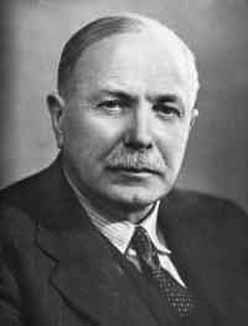


 تاريخ الرياضيات
تاريخ الرياضيات
 الرياضيات في الحضارات المختلفة
الرياضيات في الحضارات المختلفة 
 الرياضيات المتقطعة
الرياضيات المتقطعة
 الجبر
الجبر
 الهندسة
الهندسة 
 المعادلات التفاضلية و التكاملية
المعادلات التفاضلية و التكاملية 
 التحليل
التحليل
 علماء الرياضيات
علماء الرياضيات |
Read More
Date: 13-6-2017
Date: 9-6-2017
Date: 6-6-2017
|
Died: 31 December 1962 in Newnham Grange, Cambridge, England

Charles Galton Darwin's parents were Maud du Puy and Sir George Howard Darwin. Charles was a grandson of Charles Robert Darwin the author of On the origin of the species and the godson of Francis Galton. He attended Marlborough College, Wiltshire, England from 1901 to 1906 when he enteredTrinity College, Cambridge. He was Fourth Wrangler in the Mathematical Tripos of 1909.
Darwin was appointed as Reader in Mathematical Physics, Manchester University in 1910. During World War I, from 1914 to 1918, Dalton served in the Royal Engineers and the Royal Flying Corps. Then in 1919 he became a Lecturer in Mathematics at Christ's College, Cambridge. After five years at Cambridge, Darwin was appointed Tait Professor of Natural Philosophy at the University of Edinburgh in 1924. Before taking up the post he joined the Edinburgh Mathematical Society in December 1923.
Before he took up the appointment in Edinburgh, Darwin had been elected a fellow of the Royal Society in 1922. He was awarded the Society's Royal Medal in 1935. The announcement read as follows:-
The Royal Medal of the Royal Society has been awarded to Professor C G Darwin, F.R.S., of the Tate Chair of Natural Philosophy in Edinburgh University, for his researches in mathematical physics, especially in quantum mechanics.
On 3 March 1924 he was made a fellow of the Royal Society of Edinburgh, having been proposed by Sir James Alfred Ewing, Charles Glover Barkla, William Archer Tait, and Sir Edmund T Whittaker. He was on the Council of the Society from 1925 to 1928, Secretary to Ordinary Meetings 1928-1933, and Vice-President 1933-1936. He was awarded the Gunning Victoria Jubilee Prize 1932-6 of the Royal Society of Edinburgh. He married Katharine Pember in 1925, they had four sons and one daughter.
In 1936 Darwin left Edinburgh to take up the position of Master of Christ's College, Cambridge. He held this post for two years, the became Director of the National Physical Laboratory. He continued in this position until he retired in 1949.
For more details of his life and work see his Royal Astronomical Society obituary at THIS LINK.
Darwin received many honours for his outstanding work in mathematical physics. He was awarded honorary degrees by the universities of Bristol, California, Chicago, Edinburgh, Delhi, Dublin, Manchester, and St Andrews. He was knighted in 1942.
Some details of Darwin's work in mathematical physics are given in [2], the paper can be read by clicking on the above link. We end this short biography by quoting the Introduction to [1] where his contributions to eugenics are detailed:-
Charles Galton Darwin was singularly well qualified to cut a dash in the history of eugenics. His name alone strikes a unique resonance. He was a grandson of the Charles Darwin. He was a godson of the childless Francis Galton, who in formulating the principles of eugenics had been much inspired by the work of the grandfather Darwin, Galton's cousin. By heredity and upbringing, C G Darwin was himself a prime example of good breeding: like many of his illustrious forebears, he achieved intellectual eminence and was a striking demonstration that 'like begets like'. He was a committed eugenist, involved with the Eugenics Society for over thirty years, and its president for six years. Yet despite these credentials, he appears to be almost completely neglected in the historiography of the British eugenics movement. Thus one purpose of this essay is to draw out Darwin's perspectives on eugenics, and some of the factors that helped shape them.
Darwin's chronology paralleled that of the British eugenics movement. His eugenic beliefs appear to have been largely formed in times and circumstances that were relatively optimistic for eugenists. However, by the time he came to a leading position in the eugenics movement, the signs of the movement's final decline were increasingly evident. Darwin was openly torn between two beliefs - that eugenic measures were a crucial necessity as natural selection became largely suspended for much of mankind; and the desperate conclusion that all attempts to create a eugenically-determined world were almost certainly doomed to failure. In the 1950s, when Darwin was most active in the Eugenics Society, the latter was facing a similar crisis of confidence. Thus the second aim here is to demonstrate how Darwin's views in part exemplified, but often ran ahead of, the increasingly frustrated state of the British eugenics movement in its latter days. For within a year of Darwin's death, the Society took on charitable status which essentially ended its propagandising role, while in 1968, the Society's journal, "Eugenics Review", ceased publication.
We mentioned above that Darwin was a member of the Edinburgh Mathematical Society. He lectured on The Wave Mechanics at the Society's St Andrews Colloquium in July 1930.
1. T G Blaney, The Chief Sea Lion among other Wild Animals: Charles Galton Darwin and the Eugenics Movement, Galton Institute Newsletter (December 2004).
2. E C Bullard, Charles Galton Darwin (obituary), Quarterly Journal of the Royal Astronomical Society 4 (9) (1963), 316-7.
3. Charles Galton Darwin, Dictionary of National Biography 1961-1970 (1981), 272-273.
4. G P Thomson, Sir Charles Galton Darwin FRS, Biographical Memoirs of Fellows of the Royal Society 9 (1963), 69-83.



|
|
|
|
لصحة القلب والأمعاء.. 8 أطعمة لا غنى عنها
|
|
|
|
|
|
|
حل سحري لخلايا البيروفسكايت الشمسية.. يرفع كفاءتها إلى 26%
|
|
|
|
|
|
|
جامعة الكفيل تحتفي بذكرى ولادة الإمام محمد الجواد (عليه السلام)
|
|
|